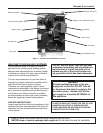
VI
CTORY
II V
HS MODELS
INSPECTION
Your boiler and heating system will last an indefinitely
long time at full efficiency, if it is inspected regularly
and is kept in good repair and adjustment. You, the
u
ser, should make regular inspections, and report any
p
roblems to your service agency. At regular intervals,
you should have that agency inspect the system, clean
the boiler and make repair adjustments as necessary.
What you and the service agency should do is listed
below. Contact your gas supplier for a list of qualified
service and repair agencies.
USER INSPECTION
The user should make the following inspections at
least once each month during the heating season and
once just before cold weather starts:
1. Venting system inspection
A.
Horizontal or vertical venting inspection
All Victory
II boilers may be vented horizontally
through an outside wall (see Figure 2), through
the roof (see Figure 3) or vertically utilizing an
existing chimney as a chase (see Figure 4). In
all cases a 3" diameter AL29-4C* stainless steel
venting material MUST be used.
Inspect the system regularly for condensation,
corrosion and/or physical damage. A qualified
professional should service the boiler annually
and include such an inspection at that time. The
homeowner should look over the system month-
ly for damage, water stains, any signs of rust,
other corrosion or separation of the flue (vent)
and fittings
.
Should an inspection turn up signs of condensa-
tion, corrosion or damage, the boiler should be
shut down immediately and the condition should
be corrected by a qualified professional.
If the boiler is vented horizontally through the
wall, the outside termination and screen should
be checked for any debris blocking the opening
and cleaned as required.
B. Chimney or Type “B” venting inspection
Only models VHS-90, VHS-120, VHS-150 and
VHS-180 may be vented directly into a chimney
with 5, 6, or 7 inch diameter standard metal smoke
pipe (galvanized). See Figure 5. Make sure pipe
joints are snug and are fastened with screws. The
chimney joint should be filled with cement to pre-
vent leakage. There should be no visible signs of
rust or salts from water evaporation.
*: AL29-4C is a registered trademark of Allegheny Ludlum Corp.
Figure 2. Horizontal venting, side wall venting
Figure 3. Vertical venting through the roof
3










